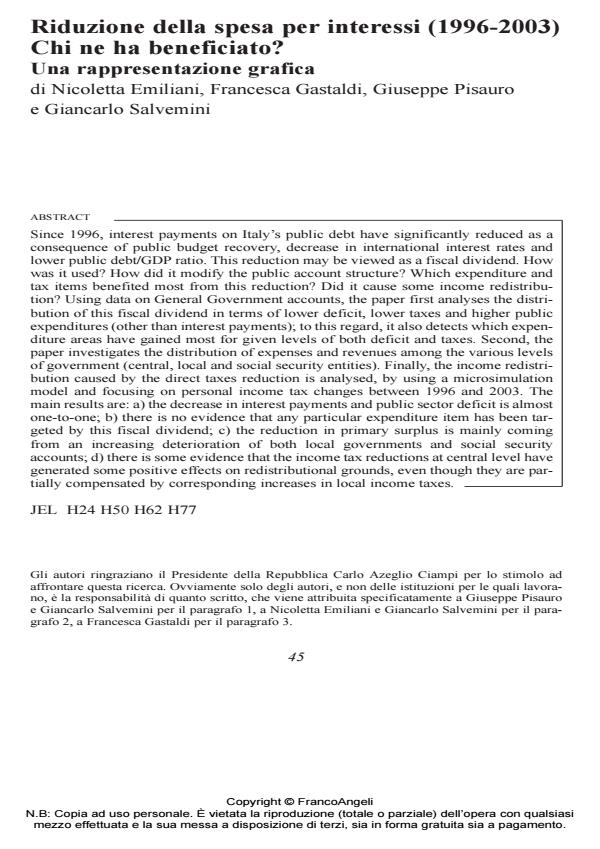Riduzione della spesa per interessi (1996-2003). Chi ne ha beneficiato? Una rappresentazione grafica
Titolo Rivista ECONOMIA PUBBLICA
Autori/Curatori Nicoletta Emiliani, Giuseppe Pisauro, Francesca Gastaldi, Giancarlo Salvemini
Anno di pubblicazione 2004 Fascicolo 2004/4 Lingua Italiano
Numero pagine 41 P. Dimensione file 717 KB
DOI
Il DOI è il codice a barre della proprietà intellettuale: per saperne di più
clicca qui
Qui sotto puoi vedere in anteprima la prima pagina di questo articolo.
Se questo articolo ti interessa, lo puoi acquistare (e scaricare in formato pdf) seguendo le facili indicazioni per acquistare il download credit. Acquista Download Credits per scaricare questo Articolo in formato PDF

FrancoAngeli è membro della Publishers International Linking Association, Inc (PILA)associazione indipendente e non profit per facilitare (attraverso i servizi tecnologici implementati da CrossRef.org) l’accesso degli studiosi ai contenuti digitali nelle pubblicazioni professionali e scientifiche
Riduzione della spesa per interessi (1996-2003). Chi ne ha beneficiato? Una rappresentanza grafica (di Nicoletta Emiliani, Francesca Gastaldi, Giuseppe Pisauro, Giancarlo Salvemini) - ABSTRACT: Since 1996, interest payments on Italy’s public debt have significantly reduced as a consequence of public budget recovery, decrease in international interest rates and lower public debt/GDP ratio. This reduction may be viewed as a fiscal dividend. How was it used? How did it modify the public account structure? Which expenditure and tax items benefited most from this reduction? Did it cause some income redistribution? Using data on General Government accounts, the paper first analyses the distribution of this fiscal dividend in terms of lower deficit, lower taxes and higher public expenditures (other than interest payments); to this regard, it also detects which expenditure areas have gained most for given levels of both deficit and taxes. Second, the paper investigates the distribution of expenses and revenues among the various levels of government (central, local and social security entities). Finally, the income redistribution caused by the direct taxes reduction is analysed, by using a microsimulation model and focusing on personal income tax changes between 1996 and 2003. The main results are: a) the decrease in interest payments and public sector deficit is almost one-to-one; b) there is no evidence that any particular expenditure item has been targeted by this fiscal dividend; c) the reduction in primary surplus is mainly coming from an increasing deterioration of both local governments and social security accounts; d) there is some evidence that the income tax reductions at central level have generated some positive effects on redistributional grounds, even though they are partially compensated by corresponding increases in local income taxes.;
Nicoletta Emiliani, Giuseppe Pisauro, Francesca Gastaldi, Giancarlo Salvemini, Riduzione della spesa per interessi (1996-2003). Chi ne ha beneficiato? Una rappresentazione grafica in "ECONOMIA PUBBLICA " 4/2004, pp , DOI: